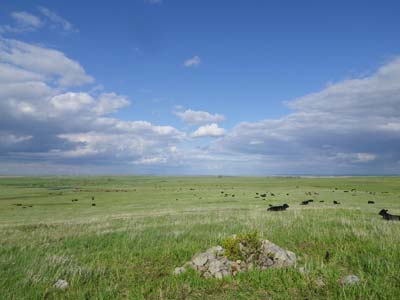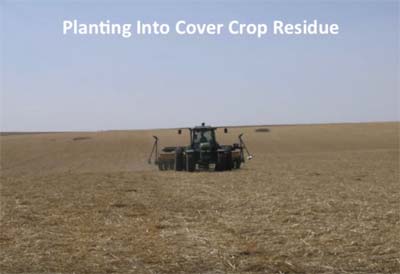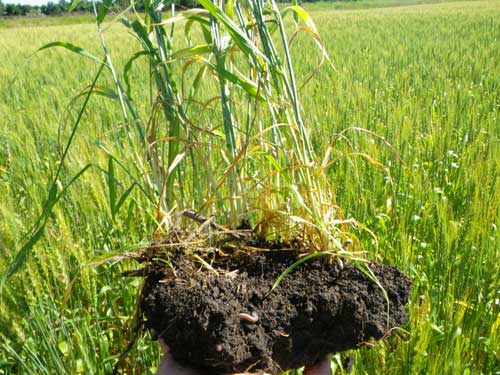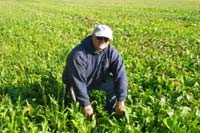Brown’s Ranch in North Dakota: Guided by the “divine”
By: K. Gregg Elliott
Posted on:11/04/2019Like almost everyone else in his rural community, Gabe had been farming and ranching using conventional methods since purchasing his Brown’s Ranch from the parents of his wife Shelly in 1991. Possibly because he had not grown up on a farm, Gabe found that he was constantly asking the question, “why do we do things this way?”
 In 1995 and 1996, Gabe Brown lost 100% of the crops planted on his 5000-acre North Dakota ranch to hail damage. Then in 1997 he lost his crop to a drought. In ’98, he lost 80% of his crop to another hailstorm. He likes to say, “God was trying to teach me the lessons I needed to learn.”
In 1995 and 1996, Gabe Brown lost 100% of the crops planted on his 5000-acre North Dakota ranch to hail damage. Then in 1997 he lost his crop to a drought. In ’98, he lost 80% of his crop to another hailstorm. He likes to say, “God was trying to teach me the lessons I needed to learn.”
Like almost everyone else in his rural community, Gabe had been farming and ranching using conventional methods since purchasing his Brown’s Ranch from the parents of his wife Shelly in 1991. Possibly because he had not grown up on a farm, Gabe found that he was constantly asking the question, “why do we do things this way?” This mindset led him to try going no-till (i.e. never breaking or turning the soil with a plow) in 1994. Unbeknownst to Gabe at the time, that is the first tenet of regenerative agriculture.
When the hail knocked down his crops in ’95 and ‘96, it left a nice covering on the soil: a cover crop “armor” for the soil, the second tenet of regenerative agriculture (though Gabe would not come to think of this practice as cover cropping until the early 2000s). By necessity, he also had to grow feed for his 300 cow-calf pairs, so he started planting a diverse mix of forage for them, again stumbling on one of the tenets of regenerative ag: diversity. Some of what he planted were biennials, such as triticale and hairy vetch, which means they were planted in the fall and then went dormant during the winter, growing again the following spring, and voilà! That is the fourth tenet of regenerative agriculture: keep living roots in the soil as long as possible. Then in 1998, he found himself unable to afford the twine required to bale his planted forage crop into hay, so he simply opened the gates and allowed his cattle to move in and graze it. As you might guess by now, Gabe had stumbled upon the fifth tenet of regenerative ag: livestock integration.
Some of what he planted were biennials, such as triticale and hairy vetch, which means they were planted in the fall and then went dormant during the winter, growing again the following spring, and voilà! That is the fourth tenet of regenerative agriculture: keep living roots in the soil as long as possible. Then in 1998, he found himself unable to afford the twine required to bale his planted forage crop into hay, so he simply opened the gates and allowed his cattle to move in and graze it. As you might guess by now, Gabe had stumbled upon the fifth tenet of regenerative ag: livestock integration.
Gabe likes to joke that he was a slow learner, but learn he did, and he has gone on to become a pioneer and leading advocate of the regenerative agriculture movement in the U.S. In addition to the cattle integrated into his operation, he added chickens in 2010, sheep in 2012, hogs in 2013 and bees in 2014.
How regenerative agriculture benefits farmers, consumers, and the environment
All of the five main practices of regenerative ag are focused on building soil health. “We can produce more at a lower cost with this kind of production model. The soil is alive if management allows it to be. Look at what the soil needs instead of what the plant needs,” says Gabe.
This focus holds great promise for increasing the carbon content in soils (carbon sequestration in agricultural soils has recently been touted for its potential in mitigating climate change). No-till and cover crops help to prevent erosion and increase organic matter in the soil, which in turn increases its moisture-holding capacity. Living roots secrete compounds into the soil that help to free up nutrients which then support not only the planted crop but also the billions of symbiotic fungi, earthworms, and microscopic invertebrates that are found in each teaspoon of healthy soil.
 Building his soil health, in turn, has allowed Gabe to completely forego pesticides and insecticides on his land for the past 15 years. “This relates to human nutrition,” he says, “by improving the soil system, we can produce more healthy foodstuffs for people.” Gabe likes to cite a statistic from Dr. Jonathan Lundgren of Blue Dasher Farms near Brookings, SD. “For every one insect species that’s a pest, there are 1700 that are either beneficial or indifferent. So as producers it makes no sense to focus on that one pest species!”
Building his soil health, in turn, has allowed Gabe to completely forego pesticides and insecticides on his land for the past 15 years. “This relates to human nutrition,” he says, “by improving the soil system, we can produce more healthy foodstuffs for people.” Gabe likes to cite a statistic from Dr. Jonathan Lundgren of Blue Dasher Farms near Brookings, SD. “For every one insect species that’s a pest, there are 1700 that are either beneficial or indifferent. So as producers it makes no sense to focus on that one pest species!”
When asked to define the difference between regenerative and organic agriculture, Gabe stresses, “I want to help move everybody forward - whether to address climate change, nitrification and phosphate pollution in our watersheds, or the human health crisis. Regenerative agriculture can help move progress in solving these problems forward and bring people together. I don’t want to pit one against another.” Having said that, he points out that the main difference he sees between the two is a much greater emphasis on no-till in regenerative agriculture.
Living the regenerative ag lifestyle
 Gabe explains that for his personal garden he drills 15 acres with “a whole bunch of vegetables” and the results are fantastic. When his wife asks what’s for supper, he says, “I go outside and whatever I trip over, that’s what we’re eating!” Every year they have excess, which they donate to needy families.
Gabe explains that for his personal garden he drills 15 acres with “a whole bunch of vegetables” and the results are fantastic. When his wife asks what’s for supper, he says, “I go outside and whatever I trip over, that’s what we’re eating!” Every year they have excess, which they donate to needy families.
The true effectiveness of the regenerative system is reflected in its bottomline. The crops and meat that Gabe sells under their Nourished by Nature trademark are very popular. “Around here,” Gabe sums up, “we have a motto that we want to sign the back of the check, not the front!”
 Sign In
Sign In
 Sign In
Sign In
